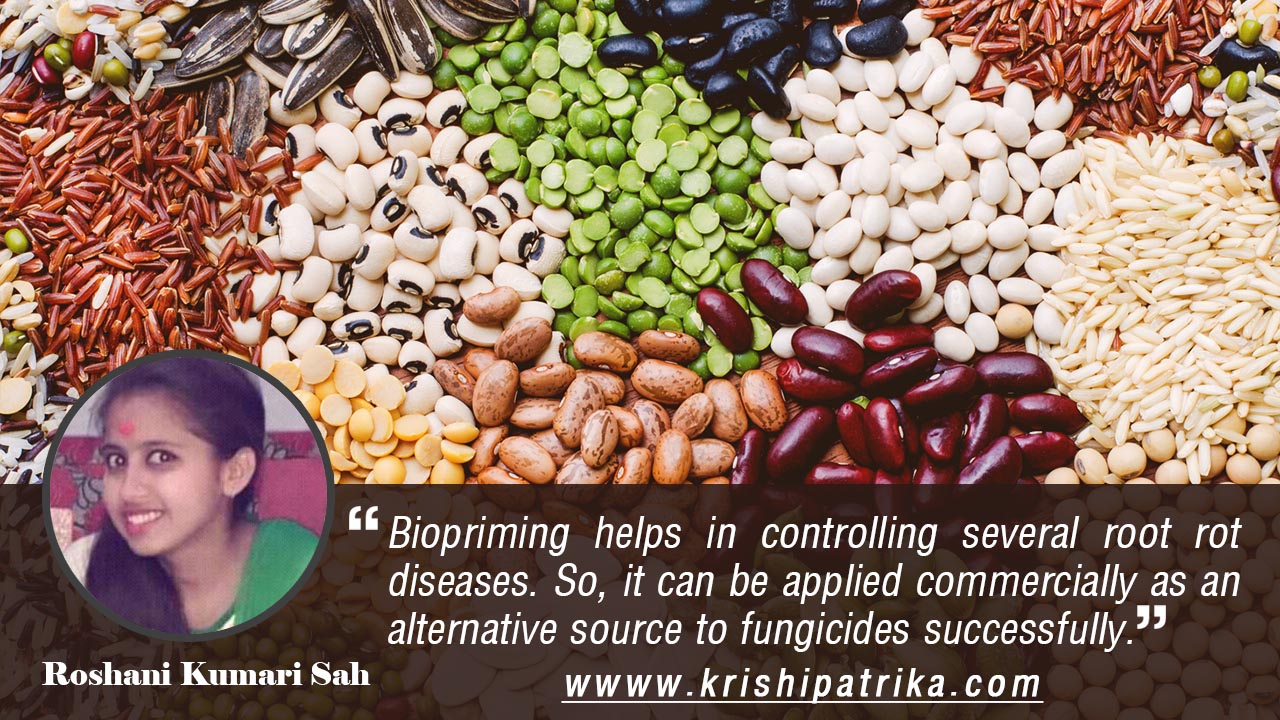
Priming of seed with living bacterial inoculum is termed as biopriming which involves the use of plant growth promoting rhizobacteria. Seed biopriming allows the bacteria to enter the seeds and acclimatization of bacteria in the prevalent conditions.
Microbes actively engaged in crop production are termed as Plant Growth Promoting Bacteria (PGPB), whereas the bacteria secluded from the root zone are known as Plant Growth Promoting Rhizobacteria. Major purposes of these beneficial microbes are supply of nutrients, improving soil structure, stimulation of plant growth producing phytohormones and biocontrol of disease causing minute living organisms.
Science behind it
Soil microbes since their discovery in the late 18th century have been used greatly in crop production. Kloepper and Schroth 1st time used the term Plant Growth Promoting Rhizobacteria (PGPR) explaining them as bacteria which are closely related to the rhizosphere. The function and mechanisms of growth promotion by these microbes have been discussed and microorganisms have been categorized into several classes. Sustainable agriculture has given importance to using rhizospheric bacteria to help plants nutrient uptake and solubilization of fixed nutrients such as; phosphorus. It is the need of the time to reduce the agricultural chemicals through combining beneficial microorganisms for better and sustainable agriculture. Various symbiotic like; rhizobium and asymbiotic bacteria like; azotobacter, azospirillum, etc. are used throughout the world to extend the crop growth and yield. Several studies have reported beneficial effects of certain rhizobial strains in upgrading growth of legumes as well as non-legumes.
Bacterial inoculation to amplify the productivity of different crops is being performed since the discovery of beneficial effects of bacteria. The techniques used for expansion of the beneficial bacteria include seed coating, pelleting, foliar application, etc. are mostly used in inoculation.
Seed coating: It is the practice of covering seeds with external materials to improve germination percentage, handling, protection and plant establishment. Seeds coated with inoculants are effective due to the germination and the development of young seedlings.
Pelleting: It is the process of compressing or molding a material into the shape of a pellet. Pelleting of seeds increases oxygen availability, accurate spacing of seed during planting, decreasing the thinning needs and generating less waste from unneeded seeds.
Foliar application: It is defined as the process of applying liquid fertilizers directly to the leaves of plants which helps in supplying major essential nutrients.
Economics of Biopriming
Several workers have supported this method being a cost effective approach for the biocontrol of different infectious microbes and application of beneficial bacteria to the soil. Biopriming can also be recommended as the possible technique for biocontrol of several plant pathogens along with the crop productivity. Control of these plant pathogens which cause infections is usually carried out by using pesticides where we can promote this approach as dual purpose technology enhancing both the plant productivity and stress resistance.
Scope of Biopriming
The use of chemical fertilizers by farmers is increasing day by day which has detrimental effects on both crops and soil. The beneficial microorganisms present in the soil are reducing due to the effects of chemicals used in the agricultural land.
Microbes are used as priming agents which offer agronomic as well as environmental advantages for agricultural systems. When planting of seeds inoculated with microbes normally emerge faster, consistent and vigorous crops stand under suitable field conditions. The experiments of biopriming carried out on different crops impart beneficial effects on germination of seeds, seed vigour, emergence of seedlings, crop stand establishment, seed tolerance to adverse environmental conditions, crop growth and increase the economic yield. There are various advantages of biopriming. Hence, inoculants are widely used to reduce the cost of production and ultimately helps to increase the crop yield. This results in sustainability in the agricultural system of Nepal.
Importance of Biopriming
- Seed biopriming increases speed and uniformity of germination.
- Seed biopriming allows the bacteria to enter into the seeds and acclimatize to the prevalent condition.
- It ensures rapid, uniform and high establishment of crops. Hence, improves harvest quality and yield.
- Rhizobia are famous intercellular Plant Growth Promoting Rhizobacteria(iPGPR) as they help in nodule formation in leguminous plants.
- They can be used effectively to meet the nutrient deficient conditions and their use can be favourable to reduce the use of chemical fertilizers.
- Biopriming helps to control damping-off disease in various crops.
Conclusion
Regarding the use of bacteria, various scientists have explained that biopriming can be used productively in application of the bacteria because it gives enough bacteria in the seeds. Opposition between inoculants and local bacteria is also a major problem that can be tackled by biopriming as the beneficial bacteria will already be inside the seeds. It helps in lowering the chance of dehydration and detrimental effects of pesticides applied to the field. On the other hand, it can also be a possible approach for the application of bacteria to small seeded crops which helps in the entrance of bacteria inside the seed. Biopriming helps in controlling several root rot diseases. So, it can be applied commercially as an alternative source to fungicides successfully. For the application, there is a need to explore for better media due to cost problems which can surely be reduced by more additional research.









